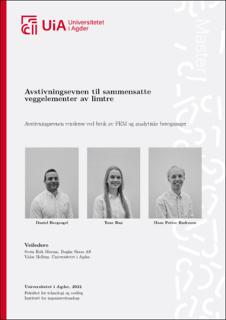| dc.description.abstract | In recent years, the use of timber in large structures has increased, partly because of its good environmental properties. One wood-based product that has emerged is the HBE-element, which practically is a 580mm high glulam beam. By stacking these on top of each other and screwing them into columns, HBE-elements can be used to build wall structures. It is, however, unknown how to document the bracing effect of such walls if they are to maintain the global stability of a building. In order to achieve global stability, a structure needs to resist horizontal loads and lead them to the foundation.
This master’s thesis aims to investigate what bracing effect can be obtained when using HBE-elements in walls, as well as how to document this effect. FEM-analyzes and other analytical calculations have been conducted, as well as literature studies. Results revealed that a bracing effect can be obtained from HBE-elements if the connections to the columns are moment stiff, as this activates the bending stiffness of the elements. Such connections proved to be difficult to obtain using screws. Other mechanisms with a bracing effect were caused by contact forces between the elements, but the contribution from these mechanisms was either insignificantly small or too uncertain to be used for documentation. | |
